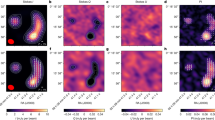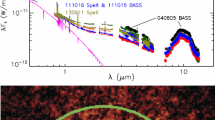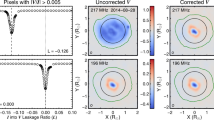Abstract
Polarized (sub)millimetre emission from dust grains in circumstellar disks was initially thought to be because of grains aligned with the magnetic field1,2. However, higher-resolution multi-wavelength observations3,4,5 and improved models6,7,8,9,10 found that this polarization is dominated by self-scattering at shorter wavelengths (for example, 870 µm) and by grains aligned with something other than magnetic fields at longer wavelengths (for example, 3 mm). Nevertheless, the polarization signal is expected to depend on the underlying substructure11,12,13, and observations until now have been unable to resolve polarization in multiple rings and gaps. HL Tau, a protoplanetary disk located 147.3 ± 0.5 pc away14, is the brightest class I or class II disk at millimetre–submillimetre wavelengths. Here we show deep, high-resolution polarization observations of HL Tau at 870 µm, resolving polarization in both the rings and the gaps. We find that the gaps have polarization angles with a notable azimuthal component and a higher polarization fraction than the rings. Our models show that the disk polarization is due to both scattering and emission from the aligned effectively prolate grains. The intrinsic polarization of aligned dust grains is probably more than 10%, which is much higher than that expected in low-resolution observations (about 1%). Asymmetries and dust features that are not seen in non-polarimetric observations are seen in the polarization observations.




Similar content being viewed by others
Data availability
This paper makes use of the following ALMA data: ADS/JAO.ALMA#2016.1.00115.S and ADS/JAO.ALMA#2019.1.01051. The observational data products generated and analysed during the current study are available in the Harvard Dataverse repository (https://dataverse.harvard.edu/dataverse/HLTau_Band7_Pol) under DOIs https://doi.org/10.7910/DVN/MM4V5M and https://doi.org/10.7910/DVN/7CQRBC. Raw ALMA data are available at ALMA Science (https://almascience.nrao.edu/aq/). Additional datasets (for example, modelling) are available from the corresponding author on request.
Code availability
This research made use of APLpy, an open-source plotting package for Python57.
References
Rao, R., Girart, J. M., Lai, S.-P. & Marrone, D. P. Detection of a magnetized disk around a very young protostar. Astrophys. J. Lett. 780, L6 (2014).
Stephens, I. W. et al. Spatially resolved magnetic field structure in the disk of a T Tauri star. Nature 514, 597–599 (2014).
Kataoka, A. et al. The evidence of radio polarization induced by the radiative grain alignment and self-scattering of dust grains in a protoplanetary disk. Astrophys. J. Lett. 844, L5 (2017).
Stephens, I. W. et al. ALMA reveals transition of polarization pattern with wavelength in HL Tau’s disk. Astrophys. J. 851, 55 (2017).
Harrison, R. E. et al. Dust polarization in four protoplanetary disks at 3 mm: further evidence of multiple origins. Astrophys. J. Lett. 877, L2 (2019).
Kataoka, A. et al. Millimeter-wave polarization of protoplanetary disks due to dust scattering. Astrophys. J. 809, 78 (2015).
Yang, H., Li, Z.-Y., Looney, L. & Stephens, I. Inclination-induced polarization of scattered millimetre radiation from protoplanetary discs: the case of HL Tau. Mon. Not. R. Astron. Soc. 456, 2794–2805 (2016).
Yang, H. Size limit of superparamagnetic inclusions in dust grains and difficulty of magnetic grain alignment in protoplanetary disks. Astrophys. J. 911, 125 (2021).
Lin, Z.-Y. D. et al. Thermal emission and scattering by aligned grains: plane-parallel model and application to multiwavelength polarization of the HL Tau disc. Mon. Not. R. Astron. Soc. 512, 3922–3947 (2022).
Lin, Z.-Y. D. et al. (Sub)millimetre dust polarization of protoplanetary discs from scattering by large millimetre-sized irregular grains. Mon. Not. R. Astron. Soc. 520, 1210–1223 (2023).
Pohl, A. et al. Investigating dust trapping in transition disks with millimeter-wave polarization. Astron. Astrophys. 593, A12 (2016).
Ohashi, S. & Kataoka, A. Radial variations in grain sizes and dust scale heights in the protoplanetary disk around HD 163296 revealed by ALMA polarization observations. Astrophys. J. 886, 103 (2019).
Lin, Z.-Y. D. et al. Validating scattering-induced (sub)millimetre disc polarization through the spectral index, wavelength-dependent polarization pattern, and polarization spectrum: the case of HD 163296. Mon. Not. R. Astron. Soc. 496, 169–181 (2020).
Galli, P. A. B. et al. The Gould’s Belt Distances Survey (GOBELINS). IV. Distance, depth, and kinematics of the Taurus star-forming region. Astrophys. J. 859, 33 (2018).
Ohashi, S. et al. Two different grain size distributions within the protoplanetary disk around HD 142527 revealed by ALMA polarization observation. Astrophys. J. 864, 81 (2018).
ALMA Partnership. et al.The 2014 ALMA Long Baseline Campaign: observations of the strongly lensed submillimeter galaxy HATLAS J090311.6 + 003906 at z = 3.042. Astrophys. J. Lett. 808, L4 (2015).
Yang, H., Li, Z.-Y., Looney, L. W., Girart, J. M. & Stephens, I. W. Scattering-produced (sub)millimetre polarization in inclined discs: optical depth effects, near-far side asymmetry and dust settling. Mon. Not. R. Astron. Soc. 472, 373–388 (2017).
Yang, H., Li, Z.-Y., Stephens, I. W., Kataoka, A. & Looney, L. Does HL Tau disc polarization in ALMA band 3 come from radiatively aligned grains? Mon. Not. R. Astron. Soc. 483, 2371–2381 (2019).
Mathis, J. S., Rumpl, W. & Nordsieck, K. H. The size distribution of interstellar grains. Astrophys. J. 217, 425–433 (1977).
Planck Collaboration. Planck intermediate results. XIX. An overview of the polarized thermal emission from Galactic dust. Astron. Astrophys. 576, A104 (2015).
Planck Collaboration. Planck intermediate results. XX. Comparison of polarized thermal emission from Galactic dust with simulations of MHD turbulence. Astron. Astrophys. 576, A105 (2015).
Pinte, C. et al. Dust and gas in the disk of HL Tauri: surface density, dust settling, and dust-to-gas ratio. Astrophys. J. 816, 25 (2016).
Tazaki, R., Tanaka, H., Kataoka, A., Okuzumi, S. & Muto, T. Unveiling dust aggregate structure in protoplanetary disks by millimeter-wave scattering polarization. Astrophys. J. 885, 52 (2019).
Yang, H. & Li, Z.-Y. The effects of dust optical properties on the scattering-induced disk polarization by millimeter-sized grains. Astrophys. J. 889, 15 (2020).
Andrews, S. M. et al. The Disk Substructures at High Angular Resolution Project (DSHARP). I. Motivation, sample, calibration, and overview. Astrophys. J. Lett. 869, L41 (2018).
Hull, C. L. H. et al. TADPOL: a 1.3 mm survey of dust polarization in star-forming cores and regions. Astrophys. J. Suppl. Ser. 213, 13 (2014).
Hull, C. L. H. & Plambeck, R. L. The 1.3 mm full-Stokes polarization system at CARMA. J. Astron. Instrum. 4, 1550005 (2015).
Birnstiel, T. et al. The Disk Substructures at High Angular Resolution Project (DSHARP). V. Interpreting ALMA maps of protoplanetary disks in terms of a dust model. Astrophys. J. Lett. 869, L45 (2018).
Yang, H. et al. Disc polarization from both emission and scattering of magnetically aligned grains: the case of NGC 1333 IRAS 4A1. Mon. Not. R. Astron. Soc. 460, 4109–4121 (2016).
Whitney, B. A. & Wolff, M. J. Scattering and absorption by aligned grains in circumstellar environments. Astrophys. J. 574, 205–231 (2002).
Dullemond, C. P. et al. RADMC-3D: a multi-purpose radiative transfer tool (Astrophysics Source Code Library, 2012).
Steinacker, J., Baes, M. & Gordon, K. D. Three-dimensional dust radiative transfer. Ann. Rev. Astron. Astrophys. 51, 63–104 (2013).
Whitney, B. A. et al. Three-dimensional radiation transfer in young stellar objects. Astrophys. J. Suppl. Ser. 207, 30 (2013).
Baes, M., Peest, C., Camps, P. & Siebenmorgen, R. Optical depth in polarised Monte Carlo radiative transfer. Astron. Astrophys. 630, A61 (2019).
Reissl, S., Wolf, S. & Brauer, R. Radiative transfer with POLARIS. I. Analysis of magnetic fields through synthetic dust continuum polarization measurements. Astron. Astrophys. 593, A87 (2016).
Peest, C., Camps, P., Stalevski, M., Baes, M. & Siebenmorgen, R. Polarization in Monte Carlo radiative transfer and dust scattering polarization signatures of spiral galaxies. Astron. Astrophys. 601, A92 (2017).
Bohren, C. F. & Huffman, D. R. Absorption and Scattering of Light by Small Particles (Wiley, 1983).
Mishchenko, M. I., Travis, L. D. & Macke, A. Scattering of light by polydisperse, randomly oriented, finite circular cylinders. Appl. Opt. 35, 4927–4940 (1996).
Mishchenko, M. I., Travis, L. D. & Mackowski, D. W. T-matrix computations of light scattering by nonspherical particles: a review. J. Quant. Spectrosc. Radiat. Transf. 55, 535–575 (1996).
Mori, T. & Kataoka, A. Modeling of the ALMA HL Tau polarization by mixture of grain alignment and self-scattering. Astrophys. J. 908, 153 (2021).
Hoang, T. & Lazarian, A. Grain alignment induced by radiative torques: effects of internal relaxation of energy and complex radiation field. Astrophys. J. 697, 1316–1333 (2009).
Chiang, E. I. & Goldreich, P. Spectral energy distributions of T Tauri stars with passive circumstellar disks. Astrophys. J. 490, 368–376 (1997).
Okuzumi, S., Ueda, T. & Turner, N. J. A global two-layer radiative transfer model for axisymmetric, shadowed protoplanetary disks. Publ. Astron. Soc. Jpn. 74, 828–850 (2022).
Carrasco-González, C. et al. The radial distribution of dust particles in the HL Tau disk from ALMA and VLA observations. Astrophys. J. 883, 71 (2019).
Hamaker, J. P. & Bregman, J. D. Understanding radio polarimetry. III. Interpreting the IAU/IEEE definitions of the Stokes parameters. Astron. Astrophys. Suppl. Ser. 117, 161–165 (1996).
Kataoka, A., Muto, T., Momose, M., Tsukagoshi, T. & Dullemond, C. P. Grain size constraints on HL Tau with polarization signature. Astrophys. J. 820, 54 (2016).
Hildebrand, R. H. et al. A primer on far-infrared polarimetry. Publ. Astron. Soc. Pac. 112, 1215–1235 (2000).
Cox, E. G. et al. High-resolution 8 mm and 1 cm polarization of IRAS 4A from the VLA Nascent Disk and Multiplicity (VANDAM) survey. Astrophys. J. Lett. 814, L28 (2015).
Cox, E. G. et al. ALMA’s polarized view of 10 protostars in the Perseus Molecular Cloud. Astrophys. J. 855, 92 (2018).
Kwon, W. et al. Highly ordered and pinched magnetic fields in the class 0 protobinary system L1448 IRS 2. Astrophys. J. 879, 25 (2019).
Le Gouellec, V. J. M. et al. A statistical analysis of dust polarization properties in ALMA observations of Class 0 protostellar cores. Astron. Astrophys. 644, A11 (2020).
Bacciotti, F. et al. ALMA observations of polarized emission toward the CW Tau and DG Tau protoplanetary disks: constraints on dust grain growth and settling. Astrophys. J. Lett. 865, L12 (2018).
Mori, T. et al. An observational study for grain dynamics in the AS 209 disk with submillimeter polarization. Astrophys. J. 883, 16 (2019).
Sadavoy, S. I. et al. Dust polarization toward embedded protostars in Ophiuchus with ALMA. III. Survey overview. Astrophys. J. Suppl. Ser. 245, 2 (2019).
Harrison, R. E. et al. ALMA CN Zeeman observations of AS 209: limits on magnetic field strength and magnetically driven accretion rate. Astrophys. J. 908, 141 (2021).
Dent, W. R. F. et al. Submillimetre dust polarization and opacity in the HD163296 protoplanetary ring system. Mon. Not. R. Astron. Soc. Lett. 482, L29–L33 (2019).
Robitaille, T. & Bressert, E. APLpy: Astronomical Plotting Library in Python (Astrophysics Source Code Library, 2012).
Acknowledgements
ALMA is a partnership of ESO (representing its member states), NSF (USA) and NINS (Japan), together with NRC (Canada), MOST and ASIAA (Taiwan) and KASI (Republic of Korea), in cooperation with the Republic of Chile. The Joint ALMA Observatory is operated by ESO, AUI/NRAO and NAOJ. The National Radio Astronomy Observatory is a facility of the National Science Foundation operated under a cooperative agreement by Associated Universities. Z.-Y.D.L. acknowledges support from NASA 80NSSC18K1095, the Jefferson Scholars Foundation, the NRAO ALMA Student Observing Support (SOS) SOSPA8-003, the Achievements Rewards for College Scientists (ARCS) Foundation Washington Chapter, the Virginia Space Grant Consortium (VSGC) and the UVA research computing (RIVANNA). Z.-Y.L. is supported in part by NASA 80NSSC20K0533 and NSF AST-2307199. L.W.L. and R.H. acknowledge support from NSF AST-1910364 and NSF AST-2307844. C.C.-G. acknowledges support from UNAM DGAPA-PAPIIT (grant no. IG101321) and from CONACyT Ciencia de Frontera (project ID 86372). R.T. acknowledges financial support from the CNES fellowship.
Author information
Authors and Affiliations
Contributions
This project was led by I.W.S. Polarization modelling was performed by Z.-Y.D.L. Data reduction was performed by M.F.-L. All authors analysed and discussed the observations and contributed to the paper.
Corresponding author
Ethics declarations
Competing interests
The authors declare no competing interests.
Peer review
Peer review information
Nature thanks the anonymous reviewers for their contribution to the peer review of this work.
Additional information
Publisher’s note Springer Nature remains neutral with regard to jurisdictional claims in published maps and institutional affiliations.
Extended data figures and tables
Extended Data Fig. 1 Polarization images of the model.
a, The colormap is the Stokes I image in mJy beam−1 and the line segments represent the polarization angle. The length of the segments are proportional to the polarization fraction with a 2% scale bar shown in the bottom. b, The linear polarization fraction image. c, The linear polarized intensity in mJy beam−1. The resolution is shown as a small white or black ellipse in the bottom right of each panel. The concentric ellipses on top of the disk mark the location of the gaps.
Extended Data Fig. 2 Comparisons of the profiles along the major axis between the observation and model.
The first three panels show the Stokes I (panel a), linear polarized intensity (panel b), and the linear polarization fraction (panel c). The observations are plotted in black solid lines with shaded areas showing the standard deviation. The dashed blue lines show the model profiles prior to beam convolution and the orange solid lines show the model profiles after beam convolution. Panel d shows the input optical depth of the model. The horizontal dotted line is where the optical depth is 1. The vertical solid lines mark the locations of the gaps.
Extended Data Fig. 3 Profiles along the minor axis.
These are plotted in a similar way as Extended Data Fig. 2. The additional panel d shows qp (see text for the definition). The positive offset is towards the northeast direction.
Extended Data Fig. 4 Model using effectively oblate grains.
Figure caption is the same as Extended Data Fig. 1, but now with oblate grains. The color scales in panels b and c have been saturated at many locations so that the morphologies of the low-level polarization fractions and intensities are visible.
Rights and permissions
Springer Nature or its licensor (e.g. a society or other partner) holds exclusive rights to this article under a publishing agreement with the author(s) or other rightsholder(s); author self-archiving of the accepted manuscript version of this article is solely governed by the terms of such publishing agreement and applicable law.
About this article
Cite this article
Stephens, I.W., Lin, ZY.D., Fernández-López, M. et al. Aligned grains and scattered light found in gaps of planet-forming disk. Nature 623, 705–708 (2023). https://doi.org/10.1038/s41586-023-06648-7
Received:
Accepted:
Published:
Issue Date:
DOI: https://doi.org/10.1038/s41586-023-06648-7
- Springer Nature Limited





